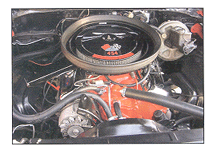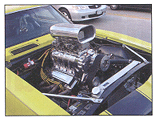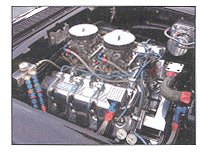As automotive technology continues to become more complex with each new model year, you may be longing for the “good ol’ days” when engines had carburetors and distributors but no sensors, fuel injectors or computers. Most driveability problems were fairly simple to diagnose and only required a trained ear and a few basic tools.
Alas, those days are gone for good (except for NASCAR). Even so, there’s still good money to be made doing restoration and performance work on classic cars and muscle cars from the 1950s, 1960s and early 1970s. Some shops tap into this market by specializing in a particular make or model (classic Mustangs, for example, or Corvettes). Others do this kind of work as a sideline to supplement their regular repair business and to get the word out to potential customers through contacts in car clubs, cruise nights, car shows and swap meets.
Working on these older low-tech engines has a number of advantages. One is that you can use all your old obsolete tune-up equipment that has been laying around in the shop collecting dust for the past 20 years (assuming you didn’t sell it or throw it away). Timing lights, dwell meters, ignition scopes, distributor machines and big box engine analyzers are still useful tools for these older engines.
Another advantage of working on pre-computer engines is their “bare bones” simplicity compared to today’s powerplants. The most complicated things you’ll have to deal with on older engines are the choke and carburetor. Early 1970s engines are also equipped with some emissions controls such as EGR valves and air pumps, and the carburetors were often fitted with “anti-tamper” caps and sealed idle mixture adjustment screws. But there are no converters on pre-1975 vehicles and no computers on pre-1980 models. Almost all of these older V8 engines are pushrod engines with flat tappet cams and timing chains. You don’t have to deal with overhead cams (except for those on the super rare Ford 427 SOHC engines), timing belts, multi-valve cylinder heads or variable valve timing. Most of the blocks and heads were cast iron and contained enough meat to allow rebuilding and milling.
Due to their age, many older vehicles are now exempt from emissions testing. In fact, most 1968 and older vehicles are totally free from emissions regulations and testing – which makes them a popular choice for hot rodders who want to drive a real performance machine without running afoul of the emissions police.
Plenty of Parts
In spite of their age, you can still find plenty of stock and performance replacement parts for older engines – especially the more popular ones such as small block and big block Chevy V8s, 289/302 Fords and 351 Fords. Most aftermarket parts suppliers still carry inventory for these older engines as do many parts stores and warehouses.
 Good used parts also are easy to find and cheap to buy. Take a stroll through any swap meet and you’ll see piles of aluminum manifolds, big valve cylinder heads, old Holley and Carter AFB four-barrel carburetors, performance distributors, camshafts, exhaust headers and tons of other bolt-on goodies. Probably 75% of all the engine parts displayed at a typical swap meet are for small block Chevys. Ford parts also are plentiful, though not in the quantities that Chevy parts are, and older big block Ford parts are getting tough to find. Oldsmobile, Pontiac and Mopar (Dodge/Plymouth/ Chrysler) performance parts are also less common. And if you’re searching for oddball stuff like a manifold or heads for an AMC, Cadillac or Studebaker, good luck!
Good used parts also are easy to find and cheap to buy. Take a stroll through any swap meet and you’ll see piles of aluminum manifolds, big valve cylinder heads, old Holley and Carter AFB four-barrel carburetors, performance distributors, camshafts, exhaust headers and tons of other bolt-on goodies. Probably 75% of all the engine parts displayed at a typical swap meet are for small block Chevys. Ford parts also are plentiful, though not in the quantities that Chevy parts are, and older big block Ford parts are getting tough to find. Oldsmobile, Pontiac and Mopar (Dodge/Plymouth/ Chrysler) performance parts are also less common. And if you’re searching for oddball stuff like a manifold or heads for an AMC, Cadillac or Studebaker, good luck!
One of the best places to search for hard-to-find parts is the Internet. Ebay Motors’ auction site has thousands of new old stock and used parts for sale. There are also hundreds of websites for specialty parts suppliers and sites dedicated exclusively to particular makes and models. The Internet also can be a good source for customers if you want to attract business from beyond your local area. You can place ads and links on muscle car and automotive-related websites and/or create your own website or home page to promote your services.
Big Spenders
The best reason for working on classic muscle cars is that the work can be extremely profitable. You can charge more per hour and not have to race against the clock to get the work done.
Most of the people who own these cars today are in their 40s, 50s or 60s and have plenty of money to spend on their baby. A lot of these people don’t have the time, the tools or the know-how to do engine work, or if they do, they’d still rather pay somebody else to do the work for them. It’s much easier for them to open up their checkbook than it is for them to open up the engine.
Most of these people will spare no expense when it comes to restoring a classic muscle car. They want it done right and are far more concerned about the results than the price. That’s quite a contrast to your typical repair shop customer who moans about every dollar you charge him for service or repairs. Muscle car owners are definitely not whiners. They won’t try to chisel you down on the price, they won’t ask you to do a lousy patch job, and, in most cases, the check won’t bounce when you deposit it in the bank.
The typical classic muscle car owner today is a big spender who often brags about how much money he’s poured into his car or cars. To this type of customer, every dollar spent on repairs and restoration is another dollar closer to realizing his personal goals for the project. What’s more, most of these cars are appreciating rapidly in value. That’s why money spent on restoring, modifying or maintaining a classic muscle car is considered more of an investment than an expense.
Most of these cars are not used for daily transportation but are driven mostly for fun or for showing off. You’ll see them in force at cruise nights, parades and car shows – but almost never see one in a Walmart parking lot (too much risk of theft, damage or vandalism). You also won’t see them out when the weather is bad or there’s salt on the streets. Most are garaged or covered and are pampered far beyond their utility as a means of transportation.
More Power!
Classic muscle cars have to live up to their reputation, which means plenty of tire-smoking power when the pedal is to the metal. Muscle cars by definition have a high power-to-weight ratio, yet some owners are never satisfied with things the way they are and want more power.
 Before we go any further, we need to point out the two basic types of muscle car owners: purists and gear heads. Purists want everything absolutely stock with matching numbers and OEM parts. They want the car to look and drive exactly the same as the day it rolled off the showroom floor. Many classic Corvette owners fall into this category.
Before we go any further, we need to point out the two basic types of muscle car owners: purists and gear heads. Purists want everything absolutely stock with matching numbers and OEM parts. They want the car to look and drive exactly the same as the day it rolled off the showroom floor. Many classic Corvette owners fall into this category.
Gear heads, on the other hand, want more performance, which means lots more horsepower, more chrome and billet aluminum parts under the hood, and maybe even something sticking up through the hood like a supercharger or tunnel ram manifold with a pair of 850 cfm 4bbl carburetors and a scoop. Gear heads want engine modifications that create more “wow” factor when people peer under their hoods. That’s why they leave the hoods open at car shows and cruise nights, to show off their engines.
 For those who want more muscle under the hood, the first step is usually to install a slew of bolt-on goodies: an aftermarket aluminum hi-rise intake manifold, a bigger four-barrel carburetor, an open-air cleaner, a set of four tube exhaust headers with low-restriction mufflers (glass packs or turbo-style mufflers), a hotter ignition system that may include a recurved distributor, higher output ignition coil and better ignition wires – plus dress-up goodies such as chrome or aluminum valve covers, pulleys, breather caps, wire looms, braided hoses, etc. Aluminum radiators and polished alternators are big buck items that add even more “wow.”
For those who want more muscle under the hood, the first step is usually to install a slew of bolt-on goodies: an aftermarket aluminum hi-rise intake manifold, a bigger four-barrel carburetor, an open-air cleaner, a set of four tube exhaust headers with low-restriction mufflers (glass packs or turbo-style mufflers), a hotter ignition system that may include a recurved distributor, higher output ignition coil and better ignition wires – plus dress-up goodies such as chrome or aluminum valve covers, pulleys, breather caps, wire looms, braided hoses, etc. Aluminum radiators and polished alternators are big buck items that add even more “wow.”
As the quest for more horsepower becomes more serious, a customer may want you to install a hotter camshaft, bigger cylinder heads and/or higher compression pistons. He may want the engine balanced, blueprinted and tweaked for maximum performance. Building performance engines requires a lot of know-how and machine shop equipment, so if you don’t have a machine shop in your area that can provide the level of expertise needed, one alternative is to install a high-performance “crate” motor. There are purpose-built long blocks complete with hot cams and big heads (usually aluminum), and often include the intake manifold as well.
Factory performance crate motors are available from Chevy, Ford and Dodge performance distributors. Aftermarket crate motors are available from a variety of engine builders. The price of a crate motor is usually quite affordable compared to having an engine custom built, and it may include a limited warranty. A performance crate motor often doesn’t cost much more than a stock motor.
Engine kits are another way to put an engine together, but the machine work will have to be farmed out if you don’t have your own machine shop equipment. The nice thing about a kit is that it gives you complete control over the assembly. The downside is that you are also completely responsible for the assembly work.
Don’t Forget Driveability
One thing to keep in mind when modifying or building an engine is that a car must be drivable to be enjoyable. A killer big block, 560-cubic-inch, 800-horsepower drag racing engine that’s built for the strip probably won’t be a very streetable engine. It will certainly have the power to light up the tires, but it will probably be a pain to drive in stop-and-go traffic. And gas mileage? Forget it!
Going overboard is probably the most common mistake most muscle car owners make when it comes to modifying a stock engine. Long-duration cams that make plenty of top-end power and create a loping idle also kill low-end torque and throttle response. A good street cam should have a power curve that runs from 1,500 rpm up to 5,500 rpm, not 4,500 to 9,000 rpm.
Reliability also becomes a concern as the power output goes up. Most V8 engines can handle an extra 50 to 150 horsepower without blowing head gaskets or throwing a rod. Most drivetrains also can handle moderate increases in power without popping U-joints, frying the clutch, blowing the rear end or trashing the transmission. But once you get on the high side of 400 horsepower, other modifications become necessary to keep things from breaking or failing.
When you’re making serious power, a stock block with two-bolt main caps may have to be upgraded to four-bolt mains. Stronger steel rods and chrome moly pushrods with stiffer valve springs may be needed to handle the loads and rpms. A larger radiator and/or supplemental electric cooling fan may be needed to keep the engine from overheating. A larger, higher pressure clutch, beefier U-joints and a stronger rear end may be needed to handle the torque. Bolt-on traction bars may be required to control wheel hop along with stiffer rear shocks and/or springs.
Upgrades also may be needed for the fuel delivery system. As the engine gobbles more gas, the stock fuel pump may not be able to keep up with the demand. A larger capacity, higher pressure pump may be needed and/or supplemented with an electric booster pump mounted near the fuel tank.
As compression goes up, so does the risk of engine-damaging detonation and preignition. The highest octane pump gas that’s normally available is 93 octane, which isn’t enough to reliably handle compression ratios above 11:1. Octane-boosting additives may be needed to keep a high compression engine from pinging under load. The other alternative is to back off the ignition timing a few degrees – but that also reduces power.
Head gasket failures also become more common at higher power levels and compression ratios. Most stock head gaskets can safely handle 400 horsepower. For higher output applications, performance head gaskets with tougher combustion chamber armor and reinforcements are usually required. Above 500 horsepower, the cylinders may have to be sealed with copper O-rings to keep the pressure where it belongs.
Choosing a Performance Cam
If a customer wants a hotter cam, choose wisely because the camshaft determines the engine’s personality and power curve. Choosing the “right” cam for a particular application means taking into account how the vehicle will actually be driven, vehicle weight, gearing, type of transmission (manual or automatic), the engine’s compression ratio, carburetion and cylinder heads. The best advice here is to follow the camshaft supplier’s recommendations – and to install a complete camshaft kit that includes new lifters, pushrods, valve springs and retainers.
As you look through the various performance camshaft manufacturer’s catalogs, you’ll notice two things. The first is that there are many different cam grinds from which to choose. The more popular the engine (small block Chevy, for example), the greater the selection of cams that are offered. The other thing is that each grind is designed for a specific type of application, so follow the cam supplier’s recommendations to the letter.
Performance cams typically have more lift and duration than a stock cam. The most common mistake that’s made when choosing a performance grind is “over-camming” the engine. Too much lift and duration in an otherwise stock engine is a bad mismatch that may hurt performance more than it helps.
When comparing cams, the numbers tell the story. These include lift, duration, overlap, lobe separation and timing. The duration specs reveal the cam’s potential for making power within a certain rpm range. Generally speaking, the longer the duration the higher the rpm range where the cam delivers its power. Short-duration cams are good for low-speed torque and throttle response (especially in heavier vehicles and those with automatic transmissions), while long-duration cams are better for high-winding engines that make lots of top-end power.
Cams with up to 220
